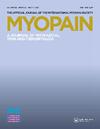Delayed Hypoalgesia to a Heat Stimulus is Induced by Eccentric Exercise and is Greater for Red- than Dark-Haired Women
引用次数: 1
Abstract
Abstract Objectives: This study sought to examine the potential delayed effect of eccentric exercise on pain perceptions of heat stimuli presented to red-haired and dark-haired women. Methods: Healthy college-aged women capable of physical exercise were sought for participation in the study. They were to assess pain intensity and unpleasantness of thermal stimuli [at 45, 47 and 49 °C] applied to their forearm and posterior lower leg before and 24 and 48 h after 18 eccentric actions of the non-dominant elbow flexors at an intensity of maximal voluntary concentric contraction strength. Women of similar age and ability served as controls and the exercise for the controls (n=6) was concentric exercise, resulting in little or no muscle injury. Results: Eighteen healthy adult women participated. Twelve [five with bright red hair and five with dark hair] subjects performed eccentric exercise. At 24- and 48-h after the eccentric exercise, the volume of the exercised arm increased by 2.2% [±1.5%] and by 5.0% [±2.2%], arm stiffness increased as evidenced by decreases in elbow range of motion of 8.3% [±6.8%] and 8.3% [±6.8%] and isometric arm strength decreased by 29.6% [±14.6%] and 17.3% [±14.0%], respectively. Analysis of variance revealed that compared to controls, pain intensity and unpleasantness were reduced by about five percent 24 and 48 h after eccentric exercise, except for the absence of an effect at 45 °C for unpleasantness. From baseline to 24 h post-exercise, significantly larger reductions in pain intensity [−17.0 versus −4.5%] and pain unpleasantness [−19.0 versus 2.3%] were found for red-haired compared to dark-haired women. Conclusion: Research summarized in this study documents eccentric exercise-induced hypoalgesia 24–48 h post-exercise that was greater in women with red hair, a prevalent phenotype among those with malfunctioning melanocortin-1 receptors.对热刺激的迟发性痛觉减退是由偏心运动引起的,红发妇女比黑发妇女更严重
摘要目的:本研究旨在探讨偏心运动对红发和黑发女性热刺激疼痛感知的潜在延迟效应。方法:寻找有体育锻炼能力的健康大学年龄女性参与研究。他们将评估在非优势肘屈肌以最大自愿同心收缩强度进行18次偏心动作之前和之后24和48小时,对前臂和小腿后部施加热刺激[45、47和49°C]的疼痛强度和不愉快程度。年龄和能力相近的女性作为对照组,对照组(n=6)的运动为同心运动,很少或没有肌肉损伤。结果:18名健康成年女性参与。12名受试者(5名红头发,5名黑发)进行了古怪的锻炼。在离心运动后24和48小时,运动臂的体积分别增加了2.2%[±1.5%]和5.0%[±2.2%],手臂僵硬度增加,肘关节活动范围分别减少了8.3%[±6.8%]和8.3%[±6.8%],手臂等距力量分别下降了29.6%[±14.6%]和17.3%[±14.0%]。方差分析显示,与对照组相比,在离心运动后24和48小时,疼痛强度和不愉快减少了约5%,除了45°C对不愉快没有影响。从基线到运动后24小时,与黑发女性相比,红发女性疼痛强度(- 17.0 vs - 4.5%)和疼痛不愉快程度(- 19.0 vs . 2.3%)的降低幅度更大。结论:本研究总结的研究表明,运动后24-48小时偏心运动引起的痛觉减退在红发女性中更为严重,红发女性是黑素皮质素-1受体功能障碍的一种普遍表型。
本文章由计算机程序翻译,如有差异,请以英文原文为准。
求助全文
约1分钟内获得全文
求助全文

 求助内容:
求助内容: 应助结果提醒方式:
应助结果提醒方式:


